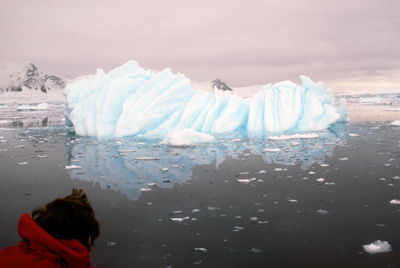The regions within the Arctic and Antarctic circles are different from the rest of the planet for a variety of reasons, not least because of the extreme climates that prevail within them. Both are largely wilderness areas hostile to human life, and because of their high latitudes both experience periods of twenty-four hour daylight or darkness. They are nevertheless quite different. The Arctic is essentially a frozen ocean surrounded by land, whereas the Antarctic is a massive continent entombed in ice and surrounded by water.
The Arctic Circle includes not only the frozen Arctic Ocean but also most of Greenland, northern regions of Europe and Siberia, and parts of Alaska and Canada. Each of these areas has its own climate and ecology, and hence offers an unique photographic environment. Greenland, for example, is the ideal destination for a travel photographer who has been everywhere else. It has settlements at very high latitudes and is generally well-served by its expensive national airline. The traditional villages, the polar bears and other wildlife, and the magnificent icebergs disgorged by the inland ice cap all make good subject.
 The long hours of daylight, and the receding snow and ice, make the period between June and September the best time to visit the Arctic. Low temperatures are potentially hazardous to both photographic equipment and film – in winter, mechanical cameras may need to be polar oiled to prevent seizure. The environment is also hazardous to human life, and polar bears can be lethal. Dress properly using multiple layers, and seek and observe local advice on safety. Glare from ice, snow and water is severe, so use UV or skylight filters, lens hood and perhaps a polarizing filter. Exposures also have to be increased by one or two stops for predominantly white scenes to avoid underexposure (see “snow scenes). Long telephoto lenses are generally necessary for photographing wildlife. Arctic light is wonderful for photography. The clear air and the red rays from the low elevation sun produce beautiful effects in images. Take many more films or memory cards than you could ever use – you may need them!
The long hours of daylight, and the receding snow and ice, make the period between June and September the best time to visit the Arctic. Low temperatures are potentially hazardous to both photographic equipment and film – in winter, mechanical cameras may need to be polar oiled to prevent seizure. The environment is also hazardous to human life, and polar bears can be lethal. Dress properly using multiple layers, and seek and observe local advice on safety. Glare from ice, snow and water is severe, so use UV or skylight filters, lens hood and perhaps a polarizing filter. Exposures also have to be increased by one or two stops for predominantly white scenes to avoid underexposure (see “snow scenes). Long telephoto lenses are generally necessary for photographing wildlife. Arctic light is wonderful for photography. The clear air and the red rays from the low elevation sun produce beautiful effects in images. Take many more films or memory cards than you could ever use – you may need them!
The Antarctic is generally much colder than the Arctic. Much of the continent is actually classified as a high-altitude desert – 9,000 feet above sea level with less than 2 inches of annual precipitation. In winter it is surrounded by a barrier of pack ice 500 miles wide, so an approach by sea is impossible. However, few photographers would choose to visit during the darkest months when temperatures plunge to below -50C. In summer, life is more bearable. Temperatures in the Antarctic Peninsula can rise above freezing, daylight extends to 20 hours per day and the wildlife is spectacularly active. Some penguin colonies are home to more than 250,000 birds and their activities vary from awe-inspiring to comical. However, an average Antarctic trip will also include sightings of whales, albatross, petrels, prions, shearwaters and, incredibly, both marine and terrestrial plants.
Photography in the Antarctic environment is subject to all the precautions associated with low temperatures, exposure adjustment and human health already described. However, it is also important to recognize the unique status of the continent and its ecology, and to do everything possible to avoid damage. Penguins, for example, suffer considerable stress when approached too closely by human beings. Although they may appear unafraid, and do not run away when approached, their heart rates may rise significantly. Their journeys to and from the sea to fetch food may also become more exhausting as they divert to longer routes. Life in Antarctica is a permanent battle for survival – don’t make it even more difficult.
Photographing wildlife is relatively easy in the sense that it is concentrated, plentiful and easy to approach. A short telephoto lens is all that is necessary in many cases. Wide-angle lenses are useful for capturing the mind-boggling scenery and the spectacular environments of the huge penguin colonies. Polarizing filters may be useful to reduce glare. It is also important to pack photographic equipment adequately in a rugged bag. This is a harsh and unforgiving environment.






